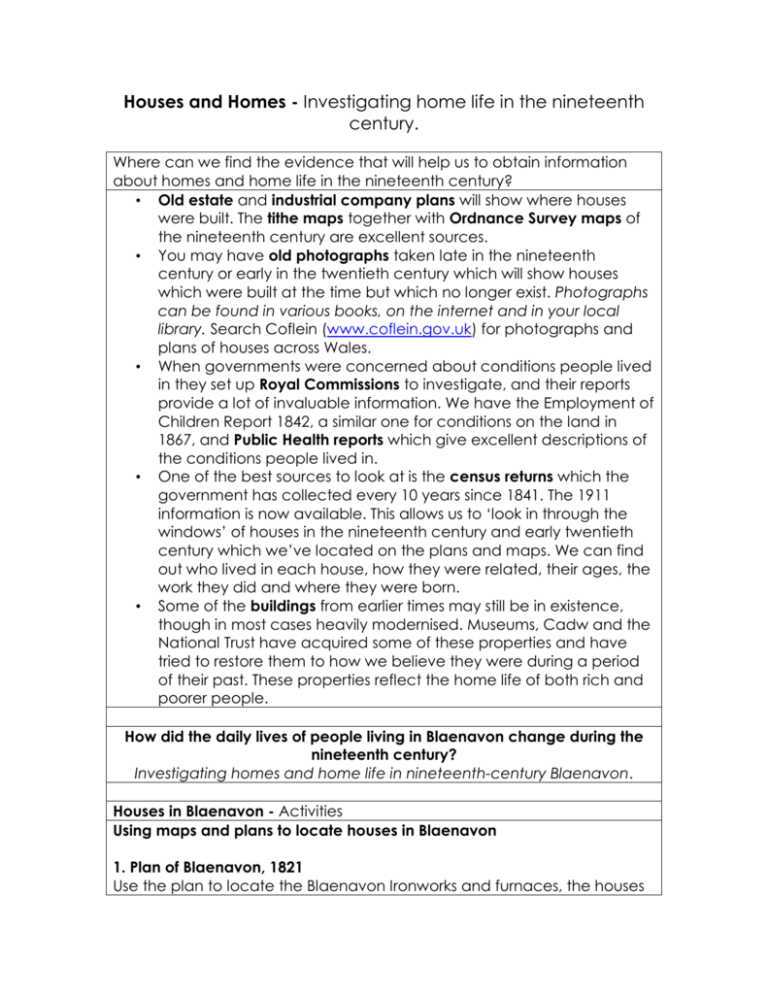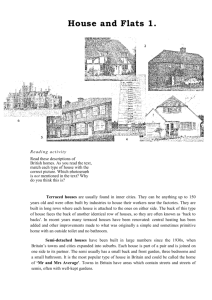Investigating Homes & Home life in (19th Blaenavon
advertisement

Houses and Homes - Investigating home life in the nineteenth century. Where can we find the evidence that will help us to obtain information about homes and home life in the nineteenth century? • Old estate and industrial company plans will show where houses were built. The tithe maps together with Ordnance Survey maps of the nineteenth century are excellent sources. • You may have old photographs taken late in the nineteenth century or early in the twentieth century which will show houses which were built at the time but which no longer exist. Photographs can be found in various books, on the internet and in your local library. Search Coflein (www.coflein.gov.uk) for photographs and plans of houses across Wales. • When governments were concerned about conditions people lived in they set up Royal Commissions to investigate, and their reports provide a lot of invaluable information. We have the Employment of Children Report 1842, a similar one for conditions on the land in 1867, and Public Health reports which give excellent descriptions of the conditions people lived in. • One of the best sources to look at is the census returns which the government has collected every 10 years since 1841. The 1911 information is now available. This allows us to ‘look in through the windows’ of houses in the nineteenth century and early twentieth century which we’ve located on the plans and maps. We can find out who lived in each house, how they were related, their ages, the work they did and where they were born. • Some of the buildings from earlier times may still be in existence, though in most cases heavily modernised. Museums, Cadw and the National Trust have acquired some of these properties and have tried to restore them to how we believe they were during a period of their past. These properties reflect the home life of both rich and poorer people. How did the daily lives of people living in Blaenavon change during the nineteenth century? Investigating homes and home life in nineteenth-century Blaenavon. Houses in Blaenavon - Activities Using maps and plans to locate houses in Blaenavon 1. Plan of Blaenavon, 1821 Use the plan to locate the Blaenavon Ironworks and furnaces, the houses near Bunkers Hill (Bunkers Row) and the Great House (Tŷ Mawr). What do you notice about where they were built? Did you notice that some of the houses were very near to the ironworks? Pupils can also study the plan to find out what else is labelled on the plan or, if they have used the plan as part of the location unit of work, to recap what they know about Blaenavon in 1821. Click on the camera icon to see a modern photograph of the Great House. Discuss: who do you think would have lived in such a house? Tŷ Mawr, or the Great House, was built between 1798 and 1800 for the ironmaster Samuel Hopkins. Compare the size of the house with those at Engine Row and Bunkers Row. Discuss the location of the houses. Why are some houses very near to the ironworks whilst others are further away? 2. OS map of Blaenavon, 1880 Use the map to locate Engine Row and Bunkers Hill. Discuss the possible location of the Bunkers Row houses. *You’ll need to use the down arrow to view Bunkers Hill. Engine Row Blaenavon Ironworks - Engine Row Engine Row cottages were built about 1788 to house key workers at the ironworks, who would have classed these iron company houses as comfortable and spacious. By 1841 the houses were lived in by labouring families. Further information about Engine Row and Stack Square cottages can be found on the Cadw website http://www.cadw.wales.gov.uk/default.asp?id=243 or in the Cadw guide, Blaenavon Ironworks and World Heritage Landscape by Peter Wakelin (Cadw, Cardiff, 2006) 1. Discuss what it would have been like living in Engine Row or Stack Square. Use the two reconstruction drawings to look for clues as to how life would have been like living so close to the ironworks. Encourage the pupils to imagine the smell and sound as well as what they could see from their homes. 2. Use the reconstruction drawing to find out more about the Engine Row houses. Discuss what information the artist would have needed to draw this reconstruction drawing of Engine Row in the mid-nineteenth century. 3. Who lived in Engine Row? Census-based activity. The census returns allow us to find out who lived in the houses, how they were related, their ages, the work they did and where they were born. Skills Framework: Developing number The pupils could create a database from the census information provided for Engine Row. Ironworkers’ Cottages in the 1840s 1. Home life during the 1840s - Engine Row cottage One of the cottages in Engine Row, at the Blaenavon Ironworks, has been refurbished by Cadw to show how it might have looked in 1841. The children can look closely at the items used at that time to try to tell what home life was like for poor families in those days. What do the objects tell us about home life in the 1840s? 2. Home life during the 1840s - newspaper reports We do not have descriptions of what the Blaenavon ironworkers’ houses were like. But we do have a newspaper account from 1849 about similar iron company houses at nearby Merthyr Tydfil. Published in The Morning Chronicle, 1849-51; taken from Eurwyn Wiliam, Rhyd-y-car: A Welsh Mining Community (National Museum Wales, Cardiff, 1987). These statements are about the better homes in the area. The statements from the newspaper can be grouped under the following headings to find out about: what the houses looked like (the design) women’s work the outside of the cottages The pupils could be split into three groups to prepare reports about the different aspects and compare life during the 1840s with today’s home life. Their reports can be presented to the rest of the class. Reflection time Discuss the importance of various sources to find out about daily life in the 1840s. Which sources were most useful? Bunkers Row Bunkers Row. The first section of these ironworkers’ housing were built about 1792 (at around the same time as Stack Square) for the lower-paid workers. The inadequacy of these small houses was noted before 1814, when detached larders were added. The houses were rebuilt c1860. Later each back-to-back pair was converted into one house. The houses were demolished in 1972. Taken from Jeremy Lowe, Welsh Industrial Workers’ Housing 1775-1875 (National Museum Wales, Cardiff, 1977). 1. Looking for clues – using photographs Look for clues in the photographs before discussing Bunkers Row houses. Compare the Bunkers Row houses with the Engine Row cottages and the Great House. 2. Looking for clues – using plans and an animation This animation produced for the Royal Commission on the Ancient and Historical Monuments of Wales, funded by the People’s Collection initiative, can be used to help pupils to find out about Bunkers Row cottages as they were in the mid-nineteenth century. It can be used with the photographs used in the previous slide and the plans drawn by an expert on housing who measured and drew the plans of the cottages he visited. The cottages were back to back and the plan shows how the cottages were joined together. Answer the questions in the activity and click on the ‘?’ icon for further questions. Interpretations of history Discuss what information was required to be able to create the animation. What was life like in 1840s and had it changed by 1900? 1. Using maps to study change over time The 1821 plan and the OS map of 1880 give us clues to the number of houses in Blaenavon during the nineteenth century. Look at the population figures for 1821 and 1881. Discuss possible reasons for the increase in the population and how the increased population would have been housed. Many families would have taken lodgers at this time. This can be seen in the census returns. 2. Rhyd-y-Car Rhyd-y-Car cottages were built for ironworkers in Merthyr Tydfil, another important iron-manufacturing town. Six of the houses have been reerected at St Fagans: National History Museum. The image shows the interior of one of the houses furnished as it might have been in 1895. The pupils can look closely at the items used in the home to try to tell what home life was like in the 1890s. Use the information gathered when studying the Engine Row cottage to discuss how home life had changed from the 1840s to the 1890s. 3. Who lived in Bunkers Row? 1841 and 1901 census This activity uses the census returns for 1841 and 1901. The census will provide information about who lived in Bunkers Row in 1841 and 1901. Information about two families is shown on the whiteboard activity. The full census for Bunkers Row is available to download as a word document. Skills Framework: Developing number Comparing data & Recording and interpreting data and presenting data. The pupils could create a database from the census information provided for Bunkers Row. Encourage the pupils to look for changes and similarities in the two censuses, e.g. number of people living in each house. Do any of the census returns studied give us any clues as to the increase in the population? Reflection time Discuss what life was like in the 1840s and whether it had changed by 1900. Discuss the range of sources used and which sources were most useful. How have Engine Row and Bunkers Row changed over time? Change over time 1. How have Engine Row and Stack Square changed over time? Discussion time What has changed in Stack Square over time? Use the images and plans to discuss how the ironworks has changed over time. Why do you think it was called Stack Square? How can these sources help us find out about the history of a location? 2. The recent history of Stack Square These photographs were taken by the Royal Commission on the Ancient and Historical Monuments of Wales of the Cadw houses at Stack Square, Blaenavon. Compare the two photographs of Stack Square. Discuss what has changed, why has it changed and why do we keep ‘old’ buildings like these? Find out about the work of the Royal Commission and Cadw. Go to their websites to find out about the work these organisations do. 3. Change over time – Bunkers Row Look at the aerial photographs. What has happened to Bunkers Row? Why do you think the houses were demolished? Discussion time. Why are some houses demolished whilst others are kept, repaired and conserved? Do you have any local examples of historic houses which have been conserved, or houses such as Bunkers Row which have been demolished? Reflection Time - historical knowledge and understanding What have we learnt about Blaenavon during the nineteenth century? How has Blaenavon changed? Historical enquiry Pupils could individually reflect upon the way in which they approached the activities and tasks set (using their Thought Journals). They could jot down what they feel worked well for them, what they could use if completing similar work again and what they may need to refine and adapt to make the approach more effective. Authors: David Maddox, Martin Williams ac Angharad Williams






